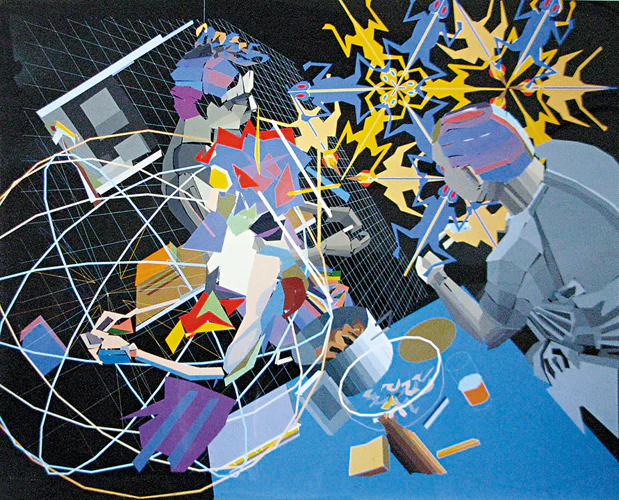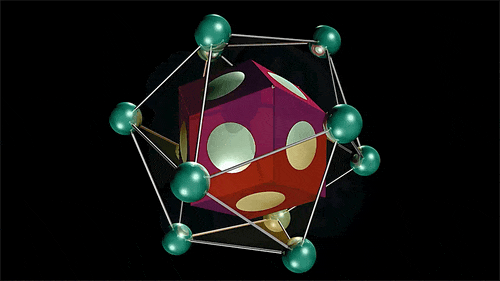Victor Acevedo is an acclaimed American artist renowned for his pioneering work in digital art, particularly in printmaking, video, and Electronic Visual Music (a term he coined in 2013 to update the name of the existing genre called Visual Music to reflect the nature of its 21st century form).
Born and raised in Los Angeles, California, he transitioned from traditional analog media in the early 1980s to fully embracing digital tools by 1985, making him one of the earliest adopters of desktop computers for fine art creation.
Now Acevedo has unveiled a new collection, Anonymous Ambience, which presents still images from the Electronic Visual Music (EVM) video work he produced in 2022. It also includes the original video itself in a small edition of multiples.
This work combines and remixes two of his earlier pieces – ’Anonymous Ambience v01’ and ‘Space Matrix v02’ – and the soundtrack is built from edited excerpts of two ambient drone tracks by the legendary circuit bender Igor Amokian (Chris Holland). It starts with a deep, machine-like humming with tones that are spaced far apart in pitch, creating a sense of vast stillness. In that space, a dodecahedron is visible, then slowly dissolves and transforms into other shifting geometric forms that pulse and breathe with the music. For viewers, the work might induce a trance-like state: the soundscape amplifies the geometries' subtle pulses, blurring sensory boundaries in a manner akin to meditation or altered consciousness.
Let’s step back and follow the artistic journey that evolved Acevedo's work from traditional painting to digital sound-synchronised geometry.
Early Work
Acevedo’s introduction to computer graphics came in 1980 through Gene Youngblood's survey class at ArtCenter, inspired by Youngblood's book Expanded Cinema. It was here Youngblood showed Acevedo Sunstone (1979) – one of the seminal early works of computer animation. It was a collaboration between artist Ed Emshwiller and NYIT researchers including Alvy Ray Smith (one of the masterminds of Lucasfilm's computer graphics division, which later became Pixar). Acevedo dubbed the experience as “life-changing”.
Acevedo's digital pivot began in 1983 with a weekend workshop at the Long Beach Museum of Art's Video Annex, led by Frank Dietrich. Using ZGRASS software on a DOS-based PC, he coded his first computer graphics – vector lines overlaying scanned photos.
By 1985, access to the Cubicomp Picture Maker system allowed 3D modeling, animation, and 24-bit color painting, outputting to videotape years before QuickTime. This era culminated in the Ectoplasmic Kitchen series (1987), a landmark body of digital prints created entirely on an IBM PC-XT with West End Film/Pansophic Artwork vector software. Overlaying polyhedral lattices on a scanned kitchen scene, these works evoked metaphysical surrealism. Debuted as projected 35mm slides at California State University, Los Angeles (1987), and in prints at Brand Library Art Gallery, Glendale (1988), the series marked Acevedo as a desktop computer art pioneer.

The Digilantes
The 1990s saw Acevedo co-found the "Digilantes" with Michael R. Wright. This informal LA collective of digital artists included Michael R. Wright, Dona Geib, and Michael J. Masucci, among others. Throughout the 90’s the group organized several underground digital art exhibitions at alternative spaces in LA. In 1992, the aforementioned Masucci along with the legendary art historian Patric Prince co-founded the Cyberspace Gallery at EZTV to counter gallery skepticism toward "computer art." Acevedo and Wright were also part of their team. A precursor to the CyberSpace Gallery was 1990 ART. This exhibition mounted at EZTV was a key event in the early history of digital art in Los Angeles, drawing a large crowd and validating the legitimacy of computer-based art in a scene that was often dismissed by the mainstream.
Electronic Visual Music
Acevedo coined the term "Electronic Visual Music" (EVM) in 2013 for abstract, sound-synchronised digital video pieces that evoke synesthesia (synesthesia is a neurological phenomenon in which stimulation of one sensory or cognitive pathway automatically and involuntarily triggers an experience in a second, unrelated pathway. In plain terms, the brain “cross-wires” the senses, so that people genuinely see, taste, feel, or smell things that aren’t actually stimulating those senses0.
Back to Anonymous Ambience
Click here to view the full collection on Objkt.com
